Imagine that for 24 years you don’t ever have hope of things getting better. Mubarak is ruling Egypt with an iron fist, while the people are captured in a cycle of paralyzing fear and hopeless apathy. We are kept from even daring to imagine a different reality from the poverty, inequity, government corruption and indignity we know. The only hope for a fresh graduate like me will be to look for chances elsewhere. Through school and university, I have already met enough bureaucracy and corruption to make me realise there is probably no way a young professional would ever make it in such an atmosphere without becoming everything I’ve always despised.
So what led to the revolution in such an unpromising situation? The call for protests started on Facebook through the group “We are all Khaled Saeed”. Saeed was a 28-year-old Egyptian from Alexandria who was beaten to death on 6 June 2010 for refusing to show his ID to two policeman. He was abducted in a police vehicle, taken to a police station, tortured to death and his corpse was later dumped in the street.
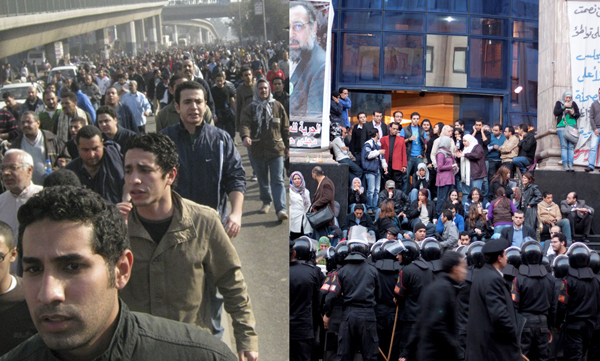

Photo: Muhammad Mahdy.
But still, the call for protests through Facebook had been going on for three years and it never really worked out for Egyptian activists. So why did the Egyptians show up in the streets in such great numbers? The success of the Tunisian revolution was the key factor. Some other factors may include the illegitimate parliamentary elections in November 2010, the rampant unemployment and corruption and a strong sense of solidarity among the Egyptian population after the bombing of the Saints Church in Alexandria on New Year's Eve. The bombing also showed that, apart from terrorising and torturing innocents, the police force wasn’t doing much.
I am from the middle-class. A class that will disappear in Egypt if things keep going the way they are. We are the educated few who get better chances and who get to spend a year or two abroad while studying. I got to see that things can operate on a different level; that we do not have to settle for what we have. I strongly believe that if the Egyptian people are given the chances of a better education, a better healthcare system and a better model to follow they will shine. I might not have suffered the most from Mubarak’s regime, but I will stand for those who suffer the most. The middle-class has a responsibility towards the working-class, no matter how the regime tried to widen the gap between us or how it frightened us from ever interacting on a meaningful level. I knew that one day we would stand up against the regime to represent a working-class that had no voice.


Photo: Muhammad Mahdy.
I currently work and reside in Hurghada, a tourist town by the Red Sea, 450km south of Cairo. I took a vacation from work for nine days starting on Tuesday 25 January to travel to Cairo and join the protests. As I was preparing to catch the bus back to Cairo on the morning of the 25th I heard the news about how a few hundred thousand people had showed up at Tahrir (literally: “liberation”) Square. I was more determined than ever to join the protests. Unfortunately, the first bus to Cairo arrived at midnight. I kept in contact with friends in the square, who told me they were able to get to Tahrir despite being attacked by the police, who were using sticks and tear gas to separate them.
Until, suddenly, phone calls to my friends at Tahrir Square were all met with the same message: “This phone cannot be reached at the moment”. The government had managed to shut down all cellphone communication in Tahrir Square.
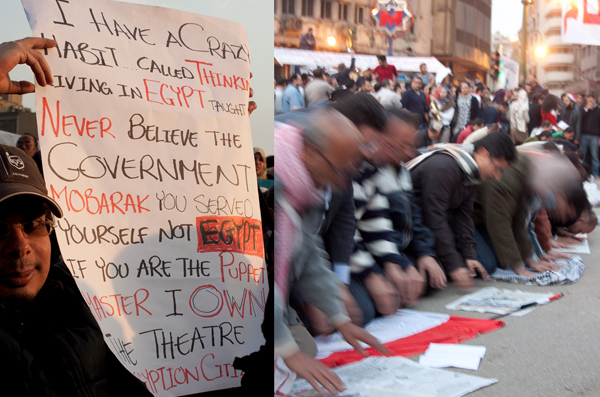

Photo: Muhammad Mahdy.
As I arrived in Cairo I received a call from a friend who told me that at about 12:30 the anti-riot police, who had surrounded the protesters for a few hours, viciously attacked the square and evacuated all protesters. Egyptian TV showed nothing of the protests. National newspapers run by the government totally ignored the protests, as if they never happened.
I was eager to join the protests the next day. As we went to Tahrir we were met by thousands of anti-riot police stationed to secure the square. Anyone between the age of 18 and 45 was asked to show his ID. One policeman approached me and my friend and asked us why we were at Tahrir and if we were going to join any of the protests. He then went on about how much trouble we would get into and, in a threatening tone, added: “You seem like you come from good families. Your parents wouldn’t like it if you were arrested.” I met his remarks with a few laughs and told him we were just hanging out in one of the cafes I knew nearby.
We walked around downtown Cairo and checked Facebook and other social websites trying to find out where the protests were. Along the way we met a few protests taking place. The biggest was in front of the lawyers' syndicate and had about 1,000 protesters. They were stopped at the gate of the syndicate by the anti-riot police and everything was kept under control. As the sun was setting, a few thousand protesters started to burn tires along the Corniche (the main road along the Nile). They were trying to make their way to the national TV building. Again the anti-riot police had complete control of the situation. Even though they had control, they had to use violence through police in civilian clothes, who suddenly held their sticks in the air and started chasing protesters.
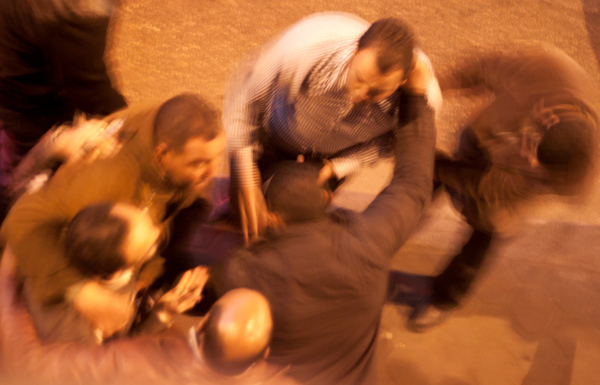

Photo: Muhammad Mahdy.
I was about 100m away from the protest and was taking pictures when two policemen in civilian outfits attacked me and tried to take my camera. One kicked me while the other started to beat me with a wooden stick, breaking one of the camera lenses I had in my bag. Luckily I was not injured. Friends and I managed to make it out of Tahrir without being caught by the police and with our cameras intact.
Another call for protests was made on Facebook for what would be known as “The Friday of Rage” on 28 January. Protests were supposed to start after the Friday prayer. The Friday prayer at noon is a weekly communal prayer and would be a perfect way to gather others who wanted to join the protests. I made plans with friends to meet at an assembly point in my neighbourhood, 15km south of downtown Cairo, and make our way to Tahrir Square, meeting other protestors on the way. To my disbelief I woke up to a communications blackout enforced by the government: No Internet, no cellphones and no SMSes – only landlines were left for people to use.
We managed to regroup at the meeting point despite problems with communication. We started out as about 2,000 people and urged bystanders and even people standing in their balconies to join us. After an hour of marching our numbers have increased to more than I can guess or even see in the narrow streets of Cairo. I could see a police station in the distance – the regime’s thugs and police officers stood with weapons in hand - sticks, knives and chains. When they saw our numbers, the thugs ran and hid in the police station, while the police officers pretended they were okay with us passing through. We chanted “Peaceful, Peaceful” and passed through; the same thing happened an hour later when we passed another police station. On my way back both these police stations had been burnt because they’d tried to stop other protesters from joining us.
Along the way we were met by cheers from people standing in their balconies. They showered us with flowers and candy, while some took the trouble to leave their homes to offer us water and food. We reached al Quasr Al-Aini Street, only 1km from Tahrir Square – 1km and about 100 anti-riot police armed with tear gas, sticks, shields and rubber bullets. We marched all the way to where they held their post and shouted: “The people don’t want the regime” and “Tell the truth officer, are you an Egyptian or not?” for about five minutes - and then they started firing at us. The tear gas was the hardest to endure, it is like taking chilli pepper and rubbing it all over your face.
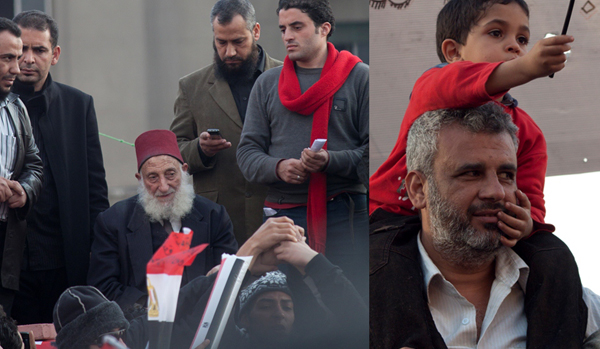

Photo: Muhammad Mahdy.
We tried to push them backwards as more and more of us fell and were replaced by protesters who had just joined us. For six hours, we fought our way to Tahrir. At about 21:00, the police were ordered to leave their posts and retreat. A speeding car with diplomatic plates ran over about 20 protesters; a few live rounds were fired and some people were injured; this made things even more uncontrollable as people reacted to seeing other protesters die in burning a National Democratic Party building nearby, trashing a nearby gas station and chasing what was left of the police force on the streets. The protesters now had total control of Tahrir Square in the middle of downtown. Military units rolled into the streets to fill the void left by the police force. That night Mubarak talked for the first time after four days of protests. His declaration was very weak and barely met any of our requests. He dissolved the current government, appointed a vice president for the first time, and dealt with the whole thing as if he had heard nothing that we had said. The speech went on for a few more minutes and sounded more like something he had said before on Labour Day.
Then there were two days with no police force. To understand why the police withdrew that way, one had to be aware that the people and the police in Egypt are not on good terms. You might say that the police withdrew as a vengeful act against the people of Egypt. We heard stories about policemen dressed as civilians terrorising neighbourhoods all over Cairo. We needed to be reminded why we needed them. We were shown horrible images on TV of the Egyptian museum being looted because the police had left their posts and there was a two-hour gap between them leaving and the army arriving in downtown Cairo. There were prison breaches all over Cairo for the same reason.
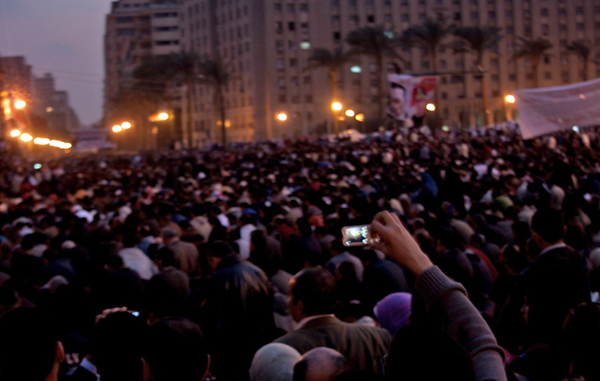

Photo: Muhammad Mahdy.
We spent one night in absolute terror. Everybody in the neighbourhood came down to the street with whatever weapon they could get. We stayed up all night protecting our homes. By the end of the night we were used to the gunshots and screams we could hear in the distance. As for the general atmosphere regarding the protests, some Egyptians who hadn't been to the protests wanted them to be over, as they blamed the protests for putting us in a situation where we had to protect ourselves. Most of the people who thought that way were either working for the government public sector or were serving in the police force or the military. The watch went peacefully, as we didn't talk much about politics - and the supply of freshly baked cakes and tea never stopped throughout the whole night.
It was now almost a week since the first day of the protests on the 25th. As day drew nearer, the streets became safer and better controlled by the army. A call for a more than a million Egyptians to protest was issued from Tahrir Square. Most of us had had to go back to protect our homes and the numbers in Tahrir were unsatisfactory, ranging between 20,000 and 50,000. The media and the regime were dealing with the protests as if those 50,000 people in Tahrir represented only themselves. We needed to send a stronger message to the regime: we were millions and did not want Mubarak as our president. By now, the protests, which had started spontaneously, had led to precise requests:
- Mubarak stepping down;
- Dissolving the illegitimate parliament;
- Taking those responsible for corruption to trial; and
- Changing the constitution to limit the president to two terms and having the presidential and parliament elections monitored by the justice department.
This time when we went to Tahrir, the picture was totally different. There was no police presence at all, and the square was monitored by the civil committees who made sure nobody had any sort of weapon on him and no police in civilian clothes entered the square, as it was obvious now who was doing all the looting and damage to public facilities. We were met with colourful signs, some of which were very funny; huge speakers played Old Egyptian national songs and people sang along. Everybody was singing and laughing, sharing food, taking pictures and enjoying the atmosphere. The main chants of the crowds were “Leave, Leave”, and “The People want the regime to step down”.
Compared to Friday this was more of a picnic. Two million people showed up at Tahrir that day: this number would have doubled had the government opened the highways for people from different parts of Egypt to join us in Cairo. Protests of the same nature took place in Alexandria and other cities – a total of 3 million were in the streets that day. It was clear that the protests were peaceful and that the civil committees did what the police failed to do in organising peaceful marches and protests.
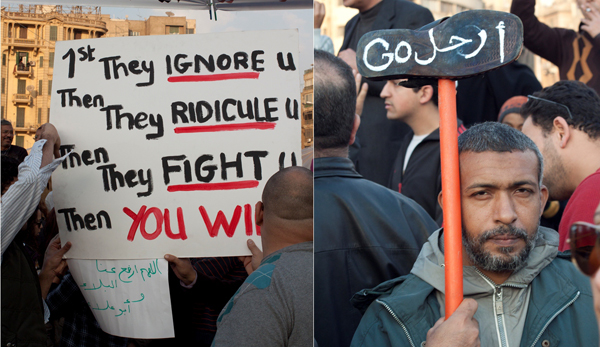

Photo: Muhammad Mahdy.
Later that night, Mubarak gave another speech. This time he declared he wouldn’t stand in the next presidential elections in nine months, he would make the amendments to the constitution asked for by the people and the justice department would look into the last parliamentary elections. He also stated he was willing to negotiate with the opposition. This time he seemed more flexible. His emotional speech – in which he talked a lot about himself and his accomplishments in war and peace – really had the desired effect on many of the people who were sympathetic to the protesters. They shifted their stance to be pro-Mubarak, asking that he stay until the end of his term.
As for us, the speech offered nothing new. After 30 years we were accustomed to the fake promises. As we all suspected, the next day when the numbers in Tahrir were about 50,000 again, thugs attacked the protesters trying to evacuate the square. In a surreal scene, camels and horses entered the square as the protesters were showered with rocks and Molotov cocktails. The protesters held their ground and called for help. Those of us who were not in the square rushed to help with supplies, medicine and to help keep our footing in Tahrir. We were met by thugs who stopped us from entering the square. This went on for about 12 hours and the new prime minister, who promised when he took the post that none of the protesters would be harmed, did nothing to help. The army units that were supposed to be protecting protestors didn't do anything either. We were back to the vicious cycle of fake promises. Eleven people were killed that day and 800 were injured. After one week the death toll was 300 and more than 3,500 injured. The huge number of deaths and injuries took the situation to a whole new level, as we were more determined than ever: No more negotiations before Mubarak leaves and all our demands were met.
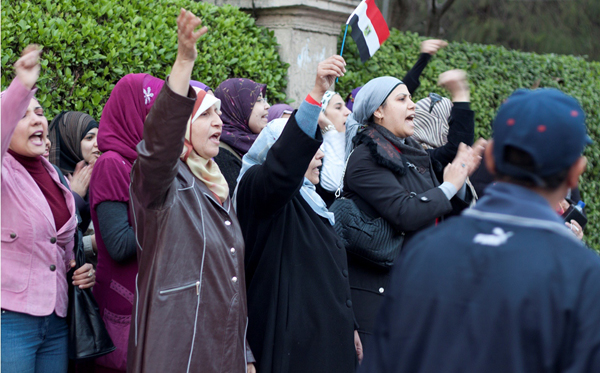

Photo: Muhammad Mahdy.
There was no official representation of the people in Tahrir. The opposition did not represent us. When the new vice president Omar Suleiman met with the leaders of the opposition, including the Muslim Brotherhood, Al Wafd Party and Al Tagamo' Party, we couldn't care less in Tahrir. For us there was really nothing to negotiate about: The demands were clear and any negotiations were in favour of the regime. When the people in Tahrir realised their revolution might be stolen by the opposition, who actually didn't participate much in Tahrir, they organised themselves and voted to elect a few of them to represent the movement in the media. Many other committees formed to talk as the voice of the people: most notably the Wisdom Circle, which included many respected Egyptian figures. Some movements were more flexible than others in their demands, but the protesters in Tahrir wanted all their demands met before any negotiations, with less emphasis on the constitutional correctness of the demands.
The Wisdom Circle was trying to reach a half-way resolution between the regime and the protesters. The opposition just ran to negotiate with the government which made them lose credibility and any sort of support they might have had from the people. It was also important to know that before these negotiations, many key figures from the ruling National Democratic Party had resigned, including Gamal Mubarak, Hosni Mubarak's own son. Safwat Al Sharif, a politician known for his devious ways, and sometimes credited as the mastermind behind all the corruption and thuggery in the streets during elections also resigned from the party, but he still kept his seat in the parliament. Ahmed Ezza, a businessman-turned-politician, who controlled 67% of steel industries in Egypt and made sure the National Democratic Party monopolised the parliament, had resigned and was called in for interrogation. Still, Mubarak was the president of the party. Protesters in Tahrir were glad but not satisfied. It was not about figures. It was about a system that gave birth to those figures.
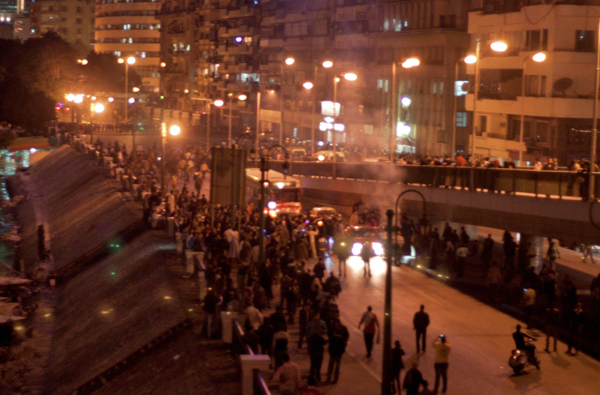

Photo: Muhammad Mahdy.
The future is uncertain. It’s a psychological struggle at the moment between the regime and the people. Who has the stronger will? Mubarak is a military man who won't give up easily. Egypt is not Tunisia. The scenario of Mubarak stepping down and escaping the country is not likely. On the other hand, Mubarak can step down and give his responsibilities to the newly appointed vice president. The problem with this scenario is that, according to the constitution, the vice president cannot make amendments to the constitution or dissolve the parliament and so the people's demands won’t be met. But in a revolution, who cares about a constitution that was written by the regime to protect the regime? All that I am certain of now is that the protests will continue as long as Mubarak is still in power.
The revolution was driven by the fury and the rage of youth against an autocratic president who has done nothing to make this country better; a government run by corrupt businessmen who are more interested in increasing the NDP than in offering better jobs and facilities; a state police that is so violent that it would lead to the death of 300 protesters and the injury of more than 3,000. Hosni Mubarak has managed to stay in power through an authoritarian regime, backed by Western countries who don’t mind all the corruption and anti-humanitarian practices as long as he kept their interests in the region safe. Now, he is trying to convince the world that the revolution is pushed by Islamic extremists and that he is the only line of defence between the Islamists and power.
If you knew him as well as we do, perhaps you would be able to see through his lies. Be aware of what is happening in Egypt because sooner or later it will affect you. DM
Hassan Elghayesh is a 24-year-old Egyptian. For a long time, he thought his only chance of a brighter future would not be in his own country, which he loves dearly. But now, the tables have turned: his faith in people's power has been restored and he feels empowered. For the first time, there is a chance of him contributing to a better Egypt. He enjoys cinema, reading, design and questioning the establishment. He is definitely happy to be part of a revolution, and he'll be back in Tahrir Square on Friday.
Main photo: Protesters chant anti-Mubarak slogans in Tahrir square in Cairo, February 8, 2011. REUTERS/Asmaa Waguih.




